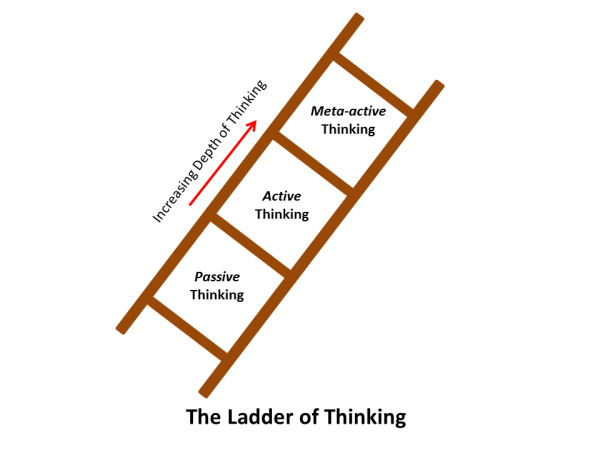When was the last time that you thought about thinking? For most of us, thinking is something that we “just do”. It is a passive response to outside stimuli that is unregulated and that we are not conscious of. That’s why, at the Extraordinary Learning Foundation™, we call this ‘Passive Thinking’.
Passive thinking is everywhere. Some teachers even think that passive thinking is a aim of education; just imagine all those drill-and-kill arithmetic exercises. Nothing could be more passive!
But what if you could be more active in your thinking? Even better, what if you could actively monitor your thinking so that you are always deploying the best type of thinking to the problem available, rather than the haphazard thinking of chance? In a world of digital natives and emergent technologies, the careers of the future will be built around thinking. Surely, it is time that we concentrated more on the donut and not the hole.
Principle Three: Meta-Active Thinking
Here, at the Extraordinary Learning Foundation™ we have developed a visual to help us visualise the different depths of thinking; The Ladder of Thinking™. The higher you proceed along The Ladder of Thinking™, the deeper the thinking.
We have found this to be a powerful visualisation for teacher and students alike.
Fleur McCurdy is a grade 7 language arts teacher at Principia P-8 School in Maine. Fleur has been working with us at the Extraordinary Learning Foundation for the last three years and has taken a particular interest in thinking. I recently visited Principia and had the pleasure of sitting-in on one of Fleur’s classes to see how this learning looks in practice.
Fleur’s smiling students enter the class. Fleur stands at the front of the room, healthy and glistening, and informs the students that they all have a question taped under their seats. One boy, Errol, has the question, “What does a circle mean?” I discuss this briefly with Fleur. “Yeah,” Says Fleur, “They generally come up with something like zero or the letter ‘O’ or something but that’s not really the point.”
As I watch, Fleur gives the instructions. “Guys, I want you to read your question and think about it. And while you’re doing that, I want you to think about how you are thinking. That’s what we’re going to report back to our arm buddies.”
The students start reading and thinking. They also have the opportunity to talk-it-out™ with their arm-buddies. The buzz in the room is inspiring.
Michelle, a slight student with vital, darting eyes, has been given the question, “If you were a knight in medieval France, how many horses would you need?” Towards the end of the class, Fleur asks Michelle to share her thinking with everybody.
“Well,” Explains Michelle, “I’ve heard of France but I don’t know where that part is; maybe the South? And I know that knights fight dragons but I’m not sure what that means for how many horses they would need.”
“So?” Asks Fleur, as she makes a little gesture with her hands that the students understand as representing ‘next steps’.
Michelle continues, “Well for my next steps then I guess I would google ‘France’.”
“Excellent!” Beams Fleur then she turns to the rest of the class and says, “Let’s affirm that thinking!” The students clap and cheer to show their support. The atmosphere is electric.

Reblogged this on The Echo Chamber.
Tait Smoogen is an anagram of Egotist Moan… Just saying!
Funny blog though.